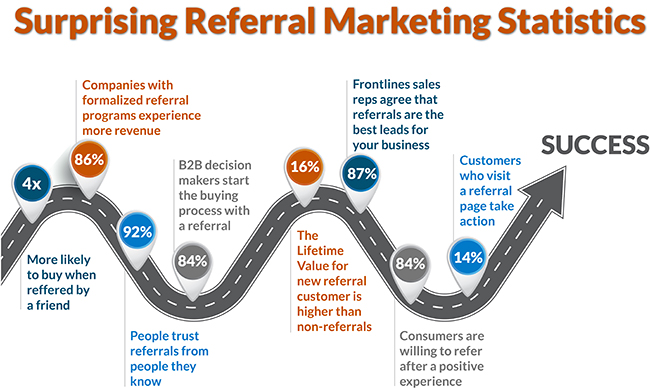

Businesses are tasked with coming come up with creative ways to attract new customers. But as you know, traditional marketing tactics can be expensive. It can be significantly more cost-effective to market to your existing customers than to find new ones. Your product and services are great, and customers love working with you, but are they telling their industry peers and colleagues about the value you provide?
Nielsen studies have shown that individuals are four times more likely to purchase a product or service when referred, and nearly half of clients are significantly impacted by posts on social media. Jim Rohn's comment that, “One client, well taken care of, could be more valuable than $10,000 worth of advertising,” is a surprisingly accurate statement.
Millions of brand related conversations take place daily across the Nation. This should leave you wondering what you can do to sway these conversations in your company's favor. Depending on attracting customers through marketing efforts alone isn't the best strategy. Referral marketing is one of the biggest drivers of revenue growth, although it's often elusive and challenging to measure.
Businesses report that word-of-mouth is their single best source of referrals.

Map out the objectives of your referral program. Is it growth and additional revenue or client retention? Successful referral programs encompass a healthy mix of these elements. Does your industry require more trust-building than others?
Determine how referrals have been coming to your business. Engage all departments and assess if they are getting referrals and how they are handling them. Ask yourself, what's an existing customer worth? With the continuous increase in the costs of marketing needed to stay ahead of competition, every hour of time and energy matters. Factoring in time spent managing on-boarding programs, how many referrals would it take to break even? A 10% conversion rate for referrals is a good starting point depending on your business size and growth targets.
Determining and defining program goals will help establish a solid foundation and roadmap for success.
What referral incentives will work best for your business? Referral incentives show customer appreciation and encourage customers to share for both B2B and B2C businesses. When you tailor incentives specific to your customers it entices them to share even more. Test different offers and see which are most effective. Try offering a discount on a current or future purchase, a gift or sample, complimentary service, or some other low-cost reward for referring new customers.
PayPal literally gave away free money, and it worked t great for them. This was before the power of social media. Dropbox famously got 4 million new users in 15 months from their referral program.
Customer referral incentive ideas:
Include an Incentive Deadline
Clients often plan to refer you to someone they know, and then as time passes information gets lost. Ensure this doesn't happen by tying your incentive to a time restriction. For instance, if a client referral buys from you in the next month, the referring client gets a voucher. Incentives, especially when combined with deadlines, entice people to refer sooner rather than later.

It may seem like you can't control who sells on your behalf, but you can with a targeted program strategy. Focus on specific segments of your client base and you will start to generate more targeted referrals and build your business by design.
Leverage Repeat Clients
To ignite growth in your company, repeat clients are contacts you should concentrate on. They are evidence of value and benefit being delivered. These customers engage with others and participate in social media. By leveraging the relationship, you can start bringing in new customers and grow through every client referral. Repeat client referrals are a source of additional revenue potential.
Avoid “Accidental” Clients
Don't rely on luck or accidental referrals – this is not an effective way to grow a business. Accidental referrals are ones that are naturally given to you. Although great to have, they are not your target. It's critical to be clear on the type of clients you want to attract and how your network can get referrals to the prospects most likely to convert to clients that are best for your business.
Identify Influencers & Champions
Identify your most fruitful business advocates as they will be an asset to your referral program. Invite your best customers. Most happy customers will root for your brand and business to do well and gladly help promote your referral program. Pleased clients evolve into your biggest fans and are more inclined to get involved with your referral program.
Learn which clients are most likely to refer you. If you identify a group of champions that will refer you on a regular basis and encourage and enable them to do so, you'll likely see more quality leads. Send an incentive offer to a segment of your happiest customers and offer the first 10 to respond with a referral a prize. You may be surprised at how fast referrals suddenly come to your customers' minds.
A targeted referral incentive program can draw in more relevant customers and help you gain a more loyal and lucrative customer base.
A critical component of a successful referral program is the ease of finding out “how it works”. This may be as easy as creating a landing page. This page not only serves to promote the program but can also help explain the terms to your current customers and those they refer. Use this opportunity to explain the benefit of joining the program and show potential earnings. It's an opportunity to include examples of the types of clients you are seeking.

Also, don't make the mistake of hiding your referral program in a sub-menu when it's such an important growth driver. Whether you showcase the program on your website's homepage, send out an email, or engage influencers to spread the word, you need to promote your referral program to succeed. More visibility means more sharing. Below are some suitable places to mention or add a link to your referral program:
You may think the referral program incentive is the most important part of a referral program, but knowledge is key as clients must know about it to take advantage of the program.
Companies large and small need to have a tracking process in place. Regardless if you employ manual methods of tracking referrals with spreadsheets, software and platforms available, or your own CRM system, it's critical to capture as much information as possible. Building a referral tracking system will enable you to make decisions necessary to maximize your referral marketing growth.
Key components to track:
Thank the referrer for helping you with a personalized message showcasing the reward to encourage additional referrals. Make it simple and incentivize to refer and repeat. There are many ways to say thanks for a coveted referral, and successful programs employ this personable tactic.
Many companies fail at actively leveraging a referral network. Don't just hope for referrals. Implement formal programs and processes that ensure you get them. A customer referral incentive program portrays your confidence in your services and team. Customers will notice this and be more comfortable sharing your information. Referral programs improve the credibility of your business and make it easier for customers to trust you.
---
Looking to develop a successful referral program for your company? A small business loan from Ascentium Capital can be used for marketing expenses like this. Our finance specialists will develop a finance program to match your unique business needs to ensure we have shared successes.
Fill out this quick form today to learn more about how we can help.
